General Electric J79
The General Electric J79 is an axial-flow turbojet engine built for use in a variety of fighter and bomber aircraft and a supersonic cruise missile. The J79 was produced by General Electric Aircraft Engines in the United States, and under license by several other companies worldwide.
| J79 | |
|---|---|
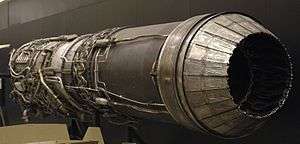 | |
| J79 on display at the National Museum of the United States Air Force | |
| Type | Afterburning turbojet |
| National origin | United States |
| Manufacturer | General Electric Aircraft Engines |
| First run | 20 May 1955 (first flight) |
| Major applications | Convair B-58 Hustler Lockheed F-104 Starfighter McDonnell Douglas F-4 Phantom II North American A-5 Vigilante |
| Number built | >17,000 [1] |
| Unit cost | $624,727 (J79-GE-3, 1960)[2] |
| Developed from | General Electric J73 |
| Variants | General Electric CJ805 |
| Developed into | General Electric CJ805-23 |
A commercial version, designated the CJ805, powered the Convair 880, while an aft-turbofan derivative, the CJ805-23, powered the Convair 990 airliners and a single Sud Aviation Caravelle intended to demonstrate to the U.S. market the benefits of a bypass engine over the existing Avon turbojet.
In 1959 the gas generator of the J79 was developed as a stationary 10MW-class (13,000 bhp) free-turbine turboshaft engine for naval power, power generation, and industrial use, called the LM1500.[3][4] Its first application was in the research hydrofoil USS Plainview.
Development
The J79 was developed in the 1950s for reliable Mach 2 performance. The USAF had a requirement to power their next generation bomber- the Convair B-58 – and this application launched the J79.[5]
The first flight of the engine was on 20 May 1955 where the engine was placed in the bomb bay of a J47-powered B-45C (48-009). The J79 was lowered from the bomb bay and the four J47s were shut down leaving the B-45 flying on the single J79.[6] The first flight after the 50-hour qualification test was on 8 December 1955, powering the second pre-production Douglas F4D Skyray, with the J79 in place of its original Westinghouse J40 engine as part of the General Electric development and qualification program. The YF-104 was the next airplane to fly with the J79 followed by a re-engined Grumman F11F Tiger in a Navy-sponsored program to gain experience with the engine before the first flight of the F4H (F-4).
The J79 was used on the F-104 Starfighter, B-58 Hustler, F-4 Phantom II, A-5 Vigilante, IAI Kfir and SSM-N-9 Regulus II supersonic cruise missile. It was produced for more than 30 years. Over 17,000 J79s were built in the US, and under license in Belgium, Canada, Germany, Israel, Italy, and Japan. A downgraded version of the F-16 Fighting Falcon with a J79 was proposed as a low-cost fighter for export, and though a prototype aircraft was flown, it found no customers.
The J79 was replaced by the late 1960s in new fighter designs by afterburning turbofans such as the Pratt & Whitney TF30 used in the F-111 and F-14, and newer generation turbofans with the Pratt & Whitney F100 used in the F-15 Eagle which give better cruise fuel efficiency by-passing air around the core of the engine.
For their part in designing the J79, Gerhard Neumann and Neil Burgess of General Electric Aircraft Engines were jointly awarded the Collier Trophy in 1958, also sharing the honor with Clarence Johnson (Lockheed F-104) and the US Air Force (Flight Records).[7]
Design
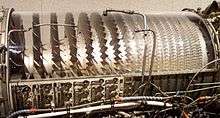
The J79 is a single-spool turbojet with a seventeen-stage compressor with, what was at the time, a novel arrangement of variable stator blades which allow the engine to develop pressure similar to a twin-spool engine at a much lower weight.
Anyone new to variable stators had to overcome the complexity of the linkages and the difficulty of sealing the pivots and airfoil root/casing clearances. Two spools needed more knowledge about bearings and sealing. GE studied both options for nearly a year before deciding, in 1952, that they should pursue variable stators for the 12:1 pressure ratio(PR) compressor.[8] Rolls-Royce had tested a rig compressor with four stages of variable stators in 1949 but did not pursue the idea at the time for the 6.5:1(PR) Avon.[9] Connors[10] tells us that Pratt and Whitney chose two spools for the 12:1(PR) J57 as they knew a lot more about bearings and sealing than about variable stators.
The J79 was originally known as the X-24A[11] and was supported by a demonstrator engine, the GOL-1590.
The compressor blades are made of stainless steel and are mounted on disks (the first seven stage's disks being made of titanium) and spaced with corrosion-resistant (not stainless) steel spacers.[12] The J79 makes a particular howling sound at certain throttle settings. This strange feature led to the NASA operated F-104B Starfighter, N819NA, being named Howling Howland.[13] Early engines also produced noticeable quantities of smoke, especially at mid-throttle/cruise settings, a disadvantage in a combat aircraft making them vulnerable to visual detection. Later models were redesigned to be "smokeless".
The turboshaft counterpart to the J79 is the General Electric LM1500, used for land and marine applications. Many J79 derived engines have found uses as gas turbine power generators in remote locations, in applications such as powering pipelines.
The J79 has two commercial derivatives: CJ805-3 (a non-afterburning engine, fitted with thrust reverser and sound suppressor), and the CJ805-23 (with a free-wheeling aft fan and thrust reverser) fitted to the Convair CV-880 and the Convair CV-990 respectively.
With air-start systems gas turbine engine compressor spools are rotated by the action of a large volume of compressed air acting directly on the compressor blades or driving the engine through a small, geared turbine motor.
Variants
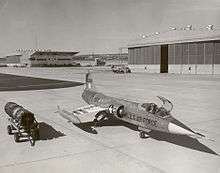
- XJ79-GE-1
- Prototype. First ground static test run on 8 June 1954 produced 14,350 lbf (63.83 kN) with afterburner.[14]
- YJ79-GE-1
- Flight test engines were designated YJ79-GE-1.
- J79-GE-2
- Powered the McDonnell F-4H-1 Phantom (F-4A), 16,100 lbf (71.62 kN) of afterburner thrust.
- J79-GE-2A
- essentially similar to the -2
- J79-GE-3
- Used in the YF-104A, F-104A and the Grumman F11F-1F Super Tiger
- J79-GE-3A
- YF-104A, F-104A and F-104B.
- J79-GE-3B
- F-104A and F-104B.
- J79-GE-5A
- Convair B-58 Hustler 15,600 lbf (69.39 kN) with afterburner.
- J79-GE-5B
- Convair B-58 Hustler 15,600 lbf (69.39 kN) with afterburner.
- J79-GE-5C
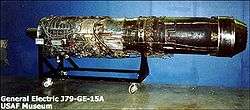
- J79-GE-7
- F-104C, F-104D and F-104F.
- J79-GE-7A
- F-104C, F-104D and F-104F.
- J79-OEL-7
- Licensed production GE-7 manufactured by Orenda Engines to power the Canadair CF-104.
- J79-GE-8
- North American A-5 Vigilante and F4H-1 (F-4B) with 16,950 lbf (75.4 kN) of afterburner thrust
- J79-GE-8A
- Sub-variant of the -8
- J79-GE-8B
- Sub-variant of the -8
- J79-GE-10
- F-4J, 17,900 lbf (79.379 kN) of afterburner thrust.
- J79-GE-11
- J79-GE-11A
- F-104G and TF-104G. 15,600 lbf (69 kN) with afterburner. Many -11 engines were licensed manufactured in Europe as part of the large F-104 consortium production programme, Alfa Romeo, Fiat and Fabrique Nationale being the main suppliers for the project.
- J79-IHI-11A
- Licensed production GE-11A, built in Japan by Ishikawajima-Harima Heavy Industries Co., Ltd to power their similarly licensed built F-104J and F-104DJ Starfighters.
- J79-MTU-J1K
- Licensed built and improved version of the GE-11A manufactured by MTU Aero Engines in Germany.
- J79-GE-15
- F-4C, RF-4C, F-4D; with 17,000 lbf (75.6kN) of afterburner thrust.
- J79-GE-17
- F-4E, RF-4E, F-4EJ, F-4F, F-4G; with 17,900 lbf (80 kN) of afterburner thrust.
- J79-GE-19
- Aeritalia F-104S; also retrofitted to F-104A's of the 319th FIS.
- J79-GE-J1E
- License-built in Israel by Beit Shemesh Engines Ltd. (BSEL) with 18,750 lbf (83.40 kN) afterburning thrust for the IAI Kfir.
- J79-GE-119
- F-16/79
Applications
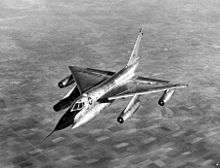
- Aircraft
- Convair B-58 Hustler
- General Dynamics F-16/79
- Grumman F11F-1F Super Tiger
- IAI Kfir
- Lockheed F-104 Starfighter
- McDonnell Douglas F-4 Phantom II
- North American A-5 Vigilante
- Northrop X-21
- SSM-N-9/RGM-15 Regulus II
- Land speed record cars
- Art Arfons' "Green Monster"
- Craig Breedlove's "Spirit of America - Sonic 1"
- North American Eagle Project
Specifications (J79-GE-17)
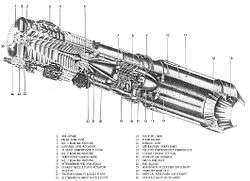
Data from
General characteristics
- Type: Afterburning turbojet engine
- Length: 208.8 in (5.30 m)
- Diameter: 38.4 in (0.98 m)
- Dry weight: 3,850 lb (1,750 kg)
Components
- Compressor: single-spool 17-stage axial compressor with variable stator vanes
- Combustors: cannular
- Turbine: 3-stage
Performance
- Maximum thrust: 11,905 lbf (52.96 kN) dry; 17,835 lbf (79.33 kN) with afterburner
- Overall pressure ratio: 13.5:1
- Air mass flow: 170 lb/s (77 kg/s)
- Turbine inlet temperature: 1,710 °F (930 °C; 1,210 K)
- Specific fuel consumption: 1.965 lb/(lbf⋅h) or 55.7 g/(kN⋅s) with afterburner, 0.85 lb/(lbf⋅h) or 24 g/(kN⋅s) at military thrust
- Thrust-to-weight ratio: 4.6
See also
- North American Eagle
- United States military aero engine designations
Related development
Comparable engines
Related lists
References
Notes
- General Electric - Aviation History Retrieved: 7 April 2008
- Pace 1992, p. 33.
- Stoeckly, E. E. (1 April 1966). "Development of the General Electric LM 1500 Gas Turbine as a Marine Power Plant". J. Eng. Power. 88 (2): 144–152. doi:10.1115/1.3678497.
- "Taking it back to 1959 when the J79 turbojet engine was reconfigured as the LM1500". General Electric. 1959.
- "seven decades of progress" General Electric, Aero Publishers Inc. Fallbrook, ISBN 0-8168-8355-6, p.76
- Pace 1992 p. 67.
- Collier Trophy winners, 1950–1959 Archived 2008-12-11 at the Wayback Machine, National Aeronautic Association. Retrieved: 7 April 2008
- "Starting Something Big" Robert V. Garvin, AIAA Inc. 1998, ISBN 1-56347289-9, p.13
- Rolls-Royce Aero Engines" Bill Gunston, Patrick Stephens Ltd. 1989, ISBN 1-85260-037-3, p.133
- The Engines of Pratt & Whitney A Technical History" Jack Connors, AIAA Inc. 2010, ISBN 978-1-60086-711-8, p.221
- "seven decades of progress" General Electric, Aero Publishers Inc. 1979, ISBN 0-8168-8355-6, p.89
- AgentJayZ (2010). "Compressor Rotor II - Turbine Engines: A Closer Look". Retrieved April 22, 2011.
- Bashow 1986, p. 16.
- Pace 1992, p. 69.
Bibliography
- Neumann, Gerhard (June 1984). Herman the German. William Morrow & Co. p. 269. ISBN 978-0-688-01682-1.
The former enemy alien and Air Corps G.I. whose inventive skills and maverick management techniques made jet engine history
- Pace, Steve. Lockheed F-104 Starfighter. Osceola, Wisconsin: Motorbooks International, 1992. ISBN 0-87938-608-8.
- Bashow, David L. Starfighter: A Loving Retrospective of the CF-104 Era in Canadian Fighter Aviation, 1961–1986. Stoney Creek, Ontario: Fortress Publications Inc., 1990. ISBN 0-919195-12-1.
- Gunston, Bill. Fighters of the Fifties. Cambridge, England. Patrick Stephens Limited, 1981. ISBN 0-85059-463-4.
- Williams, Nick and Steve Ginter "Douglas F4D Skyray". Simi Valley, California: Ginter, 1986. ISBN 0-942612-13-2.
External links
| Wikimedia Commons has media related to General Electric J79. |